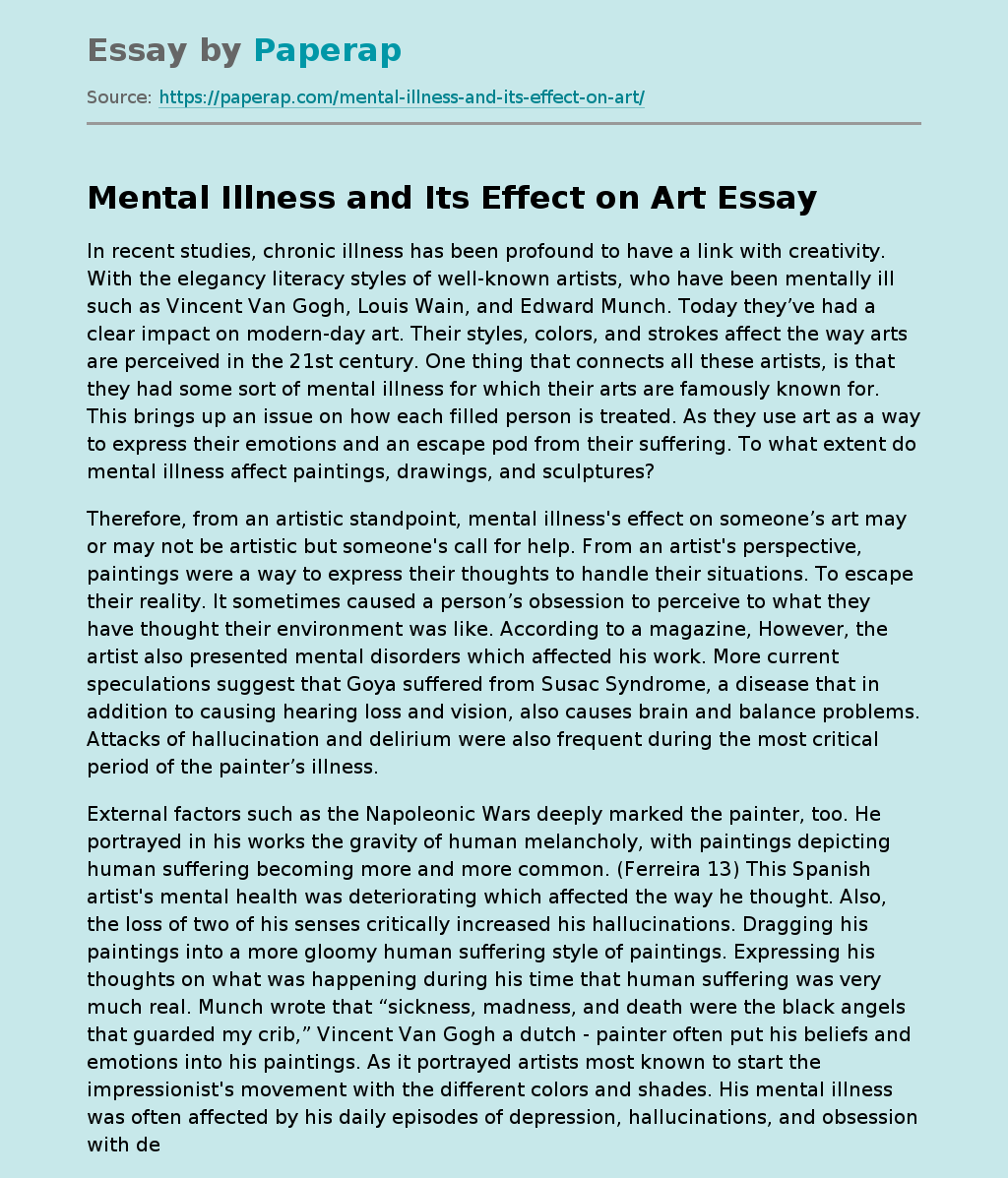Mental Illness and Its Effect on Art
In recent studies, chronic illness has been profound to have a link with creativity. With the elegancy literacy styles of well-known artists, who have been mentally ill such as Vincent Van Gogh, Louis Wain, and Edward Munch. Today they’ve had a clear impact on modern-day art. Their styles, colors, and strokes affect the way arts are perceived in the 21st century. One thing that connects all these artists, is that they had some sort of mental illness for which their arts are famously known for.
This brings up an issue on how each filled person is treated. As they use art as a way to express their emotions and an escape pod from their suffering. To what extent do mental illness affect paintings, drawings, and sculptures?
Therefore, from an artistic standpoint, mental illness’s effect on someone’s art may or may not be artistic but someone’s call for help. From an artist’s perspective, paintings were a way to express their thoughts to handle their situations.
To escape their reality. It sometimes caused a person’s obsession to perceive to what they have thought their environment was like. According to a magazine, However, the artist also presented mental disorders which affected his work. More current speculations suggest that Goya suffered from Susac Syndrome, a disease that in addition to causing hearing loss and vision, also causes brain and balance problems. Attacks of hallucination and delirium were also frequent during the most critical period of the painter’s illness.
External factors such as the Napoleonic Wars deeply marked the painter, too. He portrayed in his works the gravity of human melancholy, with paintings depicting human suffering becoming more and more common. (Ferreira 13) This Spanish artist’s mental health was deteriorating which affected the way he thought. Also, the loss of two of his senses critically increased his hallucinations. Dragging his paintings into a more gloomy human suffering style of paintings. Expressing his thoughts on what was happening during his time that human suffering was very much real. Munch wrote that “sickness, madness, and death were the black angels that guarded my crib,” Vincent Van Gogh a dutch – painter often put his beliefs and emotions into his paintings. As it portrayed artists most known to start the impressionist’s movement with the different colors and shades. His mental illness was often affected by his daily episodes of depression, hallucinations, and obsession with death which can be seen in his works. “Barred window (sketch)” Stone steps in the garden of St. Paul’s Hospital at Saint-Rémy” (Link 11) “Vestibule of St. Paul’s Hospital at Saint-Rémy” “Window of Vincent’s studio in St. Paul’s Hospital at Saint-Rémy”.
His mental illness along with his new style of paintings has made him one of the most famous and influential figures in the western world of art. According to Justin Wolf’s article, “Fauvism Movement, Artists and Major Works, “Their collective experiments with paint application, subject matter, expressive line, and pure color were advances that fed the emergence of Fauvism. Symbolism, with its emphasis on the artist’s internal vision, was another important influence.” His work created a market for rare paintings around the globe. Like his painting, “Starry Night” sold in auction for $82 million U.S. dollars. Having a great deal of talent and story of suffering was the cause of the high prices of such paintings. In addition to mental illness helping out with art and creativity, it can also be known to be political. Today black artists are fighting to be heard and recognized. Using their talents to form a social change between race and mental issues. According to the National Association on Mental Illness, “But stigma and health care barriers often result in missed opportunities for care.
Only about 25 percent of black Americans seek mental health care, compared to 40 percent of white people.” These statements prove that its socially weak to portray or receive help for a mental illness in the black community. That most fail to realize it’s the effect. Artists like Tsoku Maela a photographer from Cape Town. Uses his talent in a way to change this aspect of social acceptability. According to Toku Maela, “Depression isn’t all doom and gloom,’ Maela writes in an artist statement. ‘It’s an opportunity to face oneself and this is a result of going to places you hate the most about yourself and finding beauty.’ His work tries to reach out to young people that there’s nothing wrong with you being mentally ill as a person. This urgency to change the African community shows the effect of mental illness can have on someone’s arts. Toku Maela wants to take his gifts and his un ability to be “normal” and make it into something revolutionary in the mental illness world.
Another statement by Tsoku Maela, “It’s important to start the process of unlearning and re-educating the African community on topics such as mental health,’ Maela tells Mashable. ‘Many outlets have branded the community as ignorant, but that’s far from the truth. Ignorance is knowing the truth and choosing to look away. What we are dealing with here is a lack of knowledge on the subject.” Toku Maela uses his curse to better his community to cry out for help and wants a change in his society. Mental illness greatly influences the way paintings, drawings, and sculptures. Many artists ranging from modern to old used arts as a way to express their minds and feelings. Arts is a very effective way in coping with their struggles and help them with finding hope. Society has realized this is a big problem and has created groups to help. According to Renne Phillips, he states, “Organizations like these also help to raise awareness and educate the rest of the population about mental illness and remove the stigma associated with the conditions.”
Mental Illness and Its Effect on Art. (2021, Dec 05). Retrieved from https://paperap.com/mental-illness-and-its-effect-on-art/

